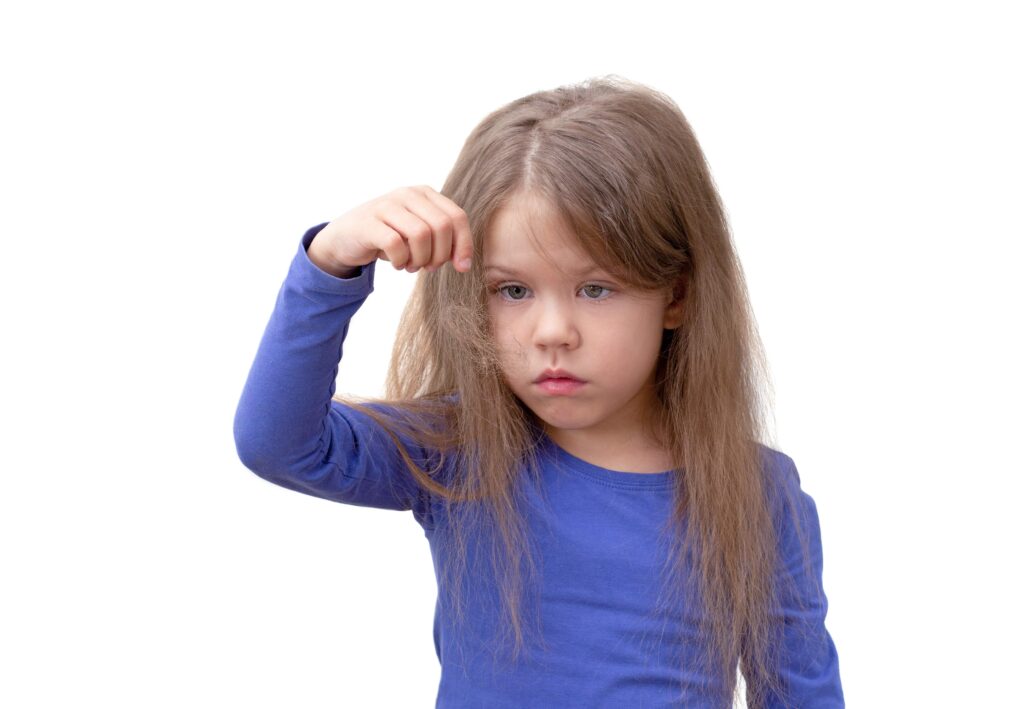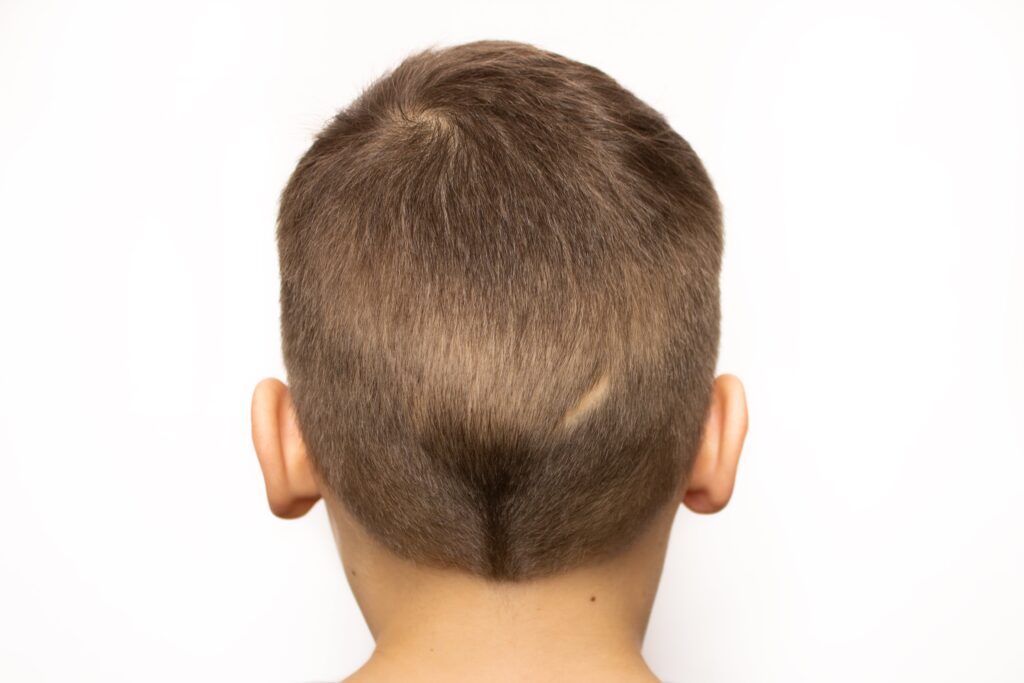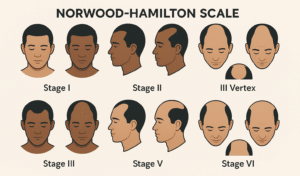When children lose their hair and bald patches form, both the child and its parents can suffer greatly from anxiety. However, hair loss is not a disease, but a symptom of a problem. Usually, the illness in question not only affects the scalp, but is a holistic problem with the skin or other organs.
In this light, when a child is suffering hair loss, a doctor – ideally a pediatric dermatologist – should carry out a thorough examination to find out the root cause. In this blogpost, we have listed the five most common problems that can lead to hair loss in children. However, this post should not be treated as a medical resource – if your child is losing his or her hair, go to a doctor.
Children can suffer from types of hair loss. The possible causes are numerous, as mentioned above. They can be diseases, genetic, or psychological stress. The following diseases can – under certain circumstances – lie behind a child’s loss of hair.
What are the possible causes for hair loss in children?

Tinea capitis – broken hairs and infected skin
This fungal infection of the scalp often occurs in children who are about to go through puberty. However, younger or older children can also suffer from it. The symptoms of tinea capitis are an itchy and red scalp, and sometimes dandruff may form.
The hair shaft on the affected area can become fragile.The scalp hair on the affected areas can break off or fall out completely. Doctors treat the highly contagious disease with an antimycotic—an anti-fungal, often in the form of a cream. It can take up to three months for patients to fully recover from the infection.
Alopecia areata – circular hair loss
Circular hair loss in children is surprisingly common. The typical symptoms of this disease appear almost overnight. They are circular or slightly oval bald spots on the scalp. Researchers have not yet conclusively studied the causes of this autoimmune disease.
What happens is is that the body’s immune system suddenly identifies the hair follicles as foreign bodies and attacks them accordingly. This in turn leads to inflammation, which makes the hair fall out. The following types of circular hair loss can occur in children:
- Alopecia Areata Circumscripta – patches of hair loss occurring in a circular way. In addition, eyelashes and eyebrows fall out.
- Alopecia Universalis – complete baldness
- Alopecia areata totalis – the entire body hair falls out
In many children, the hair grows back within a year without medication. Sometimes steroid injections are used to repress the local immune reaction. Children with alopecia areata can also have it because of hereditary causes.
Most young children affected by this pattern of hair loss are relatively relaxed about the condition. However, this can change very quickly in teenage years.
Psychological causes – e.g. stress
Children can also lose hair due to psychological disorders.
For example, children who frequently experience severe stress often suffer from diffuse hair loss. Sustained stress can cause the patient to enter a phase of telogen effluvium. This means that the hair falls out evenly all over the head. This form of hair loss is reversible.
When the stress factor is removed, the hair also grows back. However, stress can also manifest itself in various forms of obsessive-compulsive disorder, in which children deliberately damage their hair.
Trichotillomania – hair pulling
In trichotillomania, which belongs to the obsessive-compulsive disorders, those affected pull out their own hair. This often happens unconsciously, without the children giving it much thought. The brief pain of the hair pull, the relief afterwards, is a kind of outlet for those affected.
The cause is often stress, such school-related fears or the stress of parents’ divorce.
Individuals often swallow the hair they pull out. This in turn can lead to other illnesses such as nausea, vomiting, pain, and digestive problems.
Trichotemnomania
In trichotemnomania, children cut their hair but do not tell anyone. The causes are often similar to those of trichotillomania: stress, loss of a loved one or even the divorce in the family. An experienced child psychologist or psychiatrist should address trichotillomania.
Traction alopecia
Traction alopecia is a special case. It often occurs in children who often wear a strict ponytail or chignon. The constant mechanical pull on the hair can cause it to fall out under certain circumstances. Other causes of traction alopecia are frequent combing, blow-drying too hot or even certain shampoos that have an aggressive effect on the hair roots.
Wrong diet
Another reason for hair loss in children can be a poor diet. Both a deficiency and an excess of certain vitamins and minerals can cause the hair to fall out.
What can be done against hair loss in children – is a hair transplant possible?

As mentioned at the beginning, in most cases hair loss in children disappears all by itself and hair growth goes back to normal. Sometimes, however, this does not happen, especially when irreparable damage occurs to the hair roots.
In this case, a hair transplant in Turkey for young people could be one of the possible cure for alopecia areata and other forms of hair loss considering all important precautions. However, before performing this procedure, Dr. Acar will first clarify the causes and perform a very precise hair analysis to see whether reversible causes can be ruled out.
FAQ
The primary reason for hair loss in children can vary widely, but often it results from conditions like alopecia areata, fungal infections like tinea capitis, or psychological issues such as stress or trichotillomania. A thorough examination by a pediatric dermatologist is essential to identify the specific cause.
Tinea capitis, a fungal infection that leads to hair loss, is often characterized by an itchy, red scalp and fragile hair. Treatment involves antifungal medications applied topically, often in cream form, and it may take up to three months for full recovery. It is highly contagious, necessitating caution.
Alopecia areata is an autoimmune condition leading to sudden circular bald patches on the scalp. Mistakenly, the immune system attacks hair follicles, causing hair to fall out. While types vary in severity, hair often regrows within a year without medication, though some may require steroid injections.
Yes, psychological factors like severe stress can lead to hair loss, known as telogen effluvium, where hair falls out evenly across the scalp. Additionally, disorders such as trichotillomania involve children pulling out their own hair, often as a coping mechanism. Addressing the underlying stress is crucial for recovery.
While many children’s hair loss resolves naturally, severe cases with irreparable damage may warrant consideration for hair transplants. Before proceeding, a thorough evaluation by a medical professional is essential to determine the underlying causes and to rule out any reversible factors, ensuring the best decision for the child.




